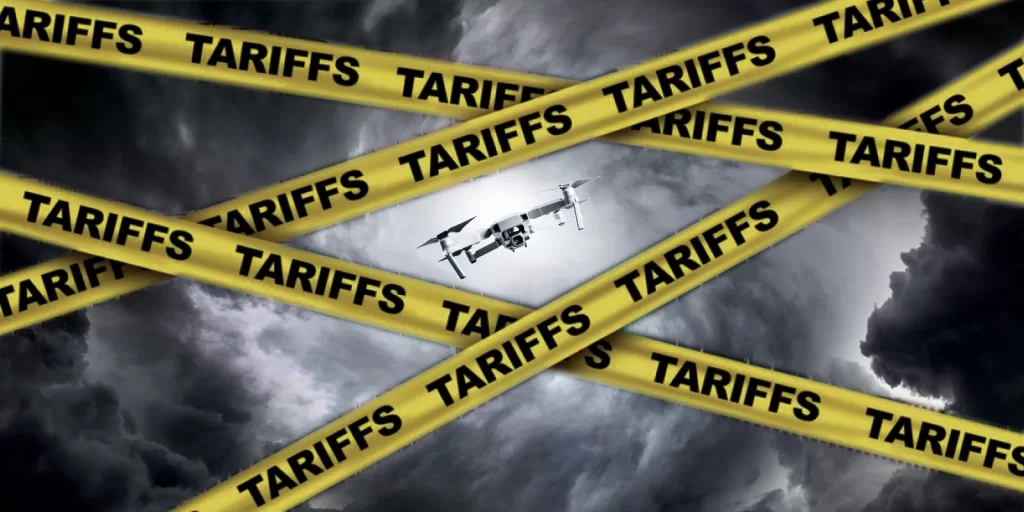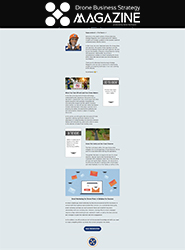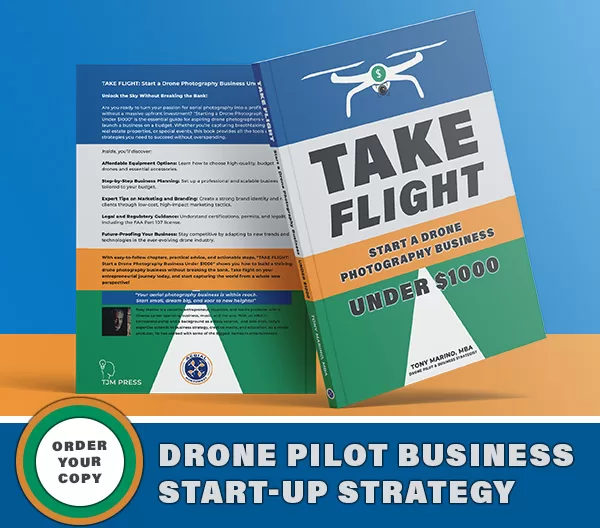
For commercial drone pilots, tariffs on imported drone components can feel like a looming storm, threatening to raise costs, disrupt supply chains, and even stunt growth. The imposition of tariffs, particularly by the Trump Administration on Chinese-made goods, has caused concern across industries—including the drone sector. The increased cost of drone parts and equipment, coupled with the uncertainty surrounding future trade policies, can leave many drone pilots wondering: How will I navigate this challenge? The truth is, while tariffs present a serious business challenge, they don’t spell the end of the road for drone pilots. By understanding the broader context of tariffs, recognizing the strategies that can help mitigate their impact, and adopting proactive business solutions, drone pilots can thrive despite these external pressures.
In this article, we’ll break down what tariffs are, explore their historical context, and most importantly, share actionable strategies that will empower you to respond effectively and continue growing your drone business in the face of these economic challenges.
Understanding Tariffs: A Quick Overview
Tariffs are taxes imposed on imported goods by governments, and they have been used for centuries to raise revenue and protect domestic industries. Tariffs can affect the cost and availability of goods, which, in turn, influences market dynamics and international trade relations. In the case of the drone industry, tariffs have become a major concern for commercial pilots and businesses, especially following the Trump Administration’s imposition of tariffs on Chinese-made goods. For drone businesses that rely on imported parts, these tariffs can significantly affect costs and operations.
While tariffs are often viewed as tools for protecting local businesses, they can also lead to economic tensions between countries. The introduction of tariffs in the U.S.—particularly on drone components manufactured in China—has raised fears among drone pilots about the potential for market disruption. However, there are strategies to mitigate the impact and navigate these challenges successfully.
A Brief History of Tariffs in the U.S.
To understand the potential implications of tariffs on the drone market, it’s important to look at the historical context of tariff usage in the U.S.
1. Early U.S. History (1789-1860)
In the early years of the nation, tariffs were one of the primary sources of revenue for the federal government, particularly before the federal income tax was introduced in 1913. The Tariff Act of 1789 established tariffs as a key mechanism to support the government and protect emerging domestic industries.
2. The Protectionist Era (1861-1933)
After the Civil War, tariffs became an essential tool for protecting U.S. industries from foreign competition. The Smoot-Hawley Tariff Act of 1930 raised tariffs to record levels, which some economists argue worsened the Great Depression by triggering retaliatory tariffs from other countries.
3. Post-WWII Trade Liberalization
After World War II, there was a shift towards trade liberalization, with agreements like the General Agreement on Tariffs and Trade (GATT) and the World Trade Organization (WTO) designed to lower global tariffs and encourage international trade. This shift toward lower tariffs fueled economic growth across the world.
4. Modern Era (1934-Present)
Tariffs have since evolved from being a primary revenue source to a tool used in trade negotiations, protectionism, and retaliation. In recent decades, the U.S. has used tariffs strategically in international trade discussions, particularly with countries like China.
5. The Trump Administration (2017-2021)
The Trump administration notably reintroduced tariffs as a central tool in its trade policy, especially in its trade war with China. The administration imposed significant tariffs on a range of Chinese goods, including electronics and drone components. This had a direct impact on drone pilots who depend on these imported parts.
Tariffs have since evolved from being a primary revenue source to a tool used in trade negotiations, protectionism, and retaliation. In recent decades, the U.S. has used tariffs strategically in international trade discussions, particularly with countries like China.
The Trump administration notably reintroduced tariffs as a central tool in its trade policy, especially in its trade war with China. The administration imposed significant tariffs on a range of Chinese goods, including electronics and drone components. This had a direct impact on drone pilots who depend on these imported parts.
Tariffs have since evolved from being a primary revenue source to a tool used in trade negotiations, protectionism, and retaliation. In recent decades, the U.S. has used tariffs strategically in international trade discussions, particularly with countries like China.
6. Current Usage and Future Considerations
Today, tariffs are still a key political and economic tool used for protecting domestic industries, retaliating against trade partners, and influencing international negotiations. For the drone industry, which relies heavily on foreign-made components, tariffs can raise operational costs and affect product availability.
Managing External Forces with PESTEL Analysis
In the face of shifting trade policies and tariffs, commercial drone pilots and businesses must remain agile and proactive. One valuable tool for assessing and responding to these external forces is PESTEL analysis, which helps businesses evaluate the following factors:
1. Political Factors
Tariffs are often used as a political tool, and changes in government policy can directly impact businesses. For instance, during the Trump administration, tariffs were imposed on Chinese-made drones and drone parts, such as gimbals and cameras, which led to price increases for many drone pilots. If a new administration shifts policies to reduce tariffs or ease trade tensions, it can help lower costs and make drone parts more affordable. Staying informed about political developments, such as changes in trade agreements (e.g., USMCA—United States-Mexico-Canada Agreement), is crucial for anticipating how these changes could affect your business.
2. Economic Factors
Economic conditions, including inflation and exchange rates, can impact drone businesses significantly. If tariffs increase the price of Chinese-made drone parts by 25%, a pilot might face higher operational costs, squeezing profit margins. Additionally, fluctuations in currency exchange rates can affect international suppliers and increase the price of imported drones. Pilots need to adjust their business strategies accordingly, potentially raising their prices or finding ways to improve operational efficiency to maintain profitability.
3. Social Factors
Public opinion and societal attitudes towards international trade can influence political decisions that impact tariffs. During the US-China trade war, public concerns about economic fairness and intellectual property theft contributed to the imposition of tariffs on Chinese drone manufacturers. As a commercial drone pilot, you may encounter customers who are socially conscious about trade issues and prefer drones from manufacturers that align with ethical practices. You can use this awareness to position your business in a way that appeals to socially responsible consumers.
4. Technological Factors
The drone industry is heavily reliant on technological advancements, many of which come from overseas manufacturers. For example, during the 2018 U.S.-China trade war, tariffs were placed on drone components like cameras, sensors, and processors. This affected the price and availability of drone technology, slowing innovation for some manufacturers. As a drone pilot, staying informed about technological disruptions, such as new innovations in drone components or alternative suppliers, will help you adapt quickly to changes in the marketplace. Diversifying your sources of equipment or investing in domestic alternatives can help mitigate the impact of tariffs.
5. Environmental Factors
While not always directly related to tariffs, environmental concerns and regulations can influence trade policies. For example, if governments implement tariffs on drones and their components to promote sustainability or address pollution, the drone industry may be affected. The EU’s Green Deal includes sustainability initiatives that could increase tariffs on products that don’t meet environmental standards. Pilots who invest in eco-friendly drones or offer sustainability-focused services will be better positioned to meet regulatory expectations and cater to environmentally conscious clients.
6. Legal Factors
Legal changes, such as intellectual property laws and trade regulations, can have significant consequences for the drone industry. During the US-China trade dispute, the U.S. government imposed bans on certain Chinese-made drones due to concerns over cybersecurity and intellectual property theft. Staying updated on evolving IP laws and trade regulations is crucial for drone pilots. For example, if certain drone manufacturers are banned, you may need to find alternatives or ensure that the drones you use comply with national security guidelines.
How Commercial Drone Pilots Can Respond
While the fear of tariffs and external trade forces is understandable, there are several proactive strategies that commercial drone pilots can employ to mitigate the impact on their businesses. By adapting and responding to these external challenges, pilots can not only survive but thrive in an evolving market. Here’s an expanded look at these five key strategies:
1. Diversify Supply Chains
Reducing reliance on imported components from countries that are subject to tariffs is one of the most effective ways to safeguard your business from price hikes and supply chain disruptions.
Here’s how drone pilots can diversify their supply chains:
Source from Multiple Suppliers: Instead of depending on one country or manufacturer for all drone parts (such as batteries, cameras, gimbals, etc.), consider sourcing components from different countries or regions. For example, if you rely on Chinese-made drone parts, explore alternatives from Europe, the U.S., or even other parts of Asia that may not be subject to the same tariff rates.
Domestic Manufacturers: Explore opportunities to buy from domestic manufacturers. Not only can this reduce exposure to tariffs, but it can also create new opportunities for faster delivery times and better customer service. While domestic components may be more expensive, some pilots may find that the benefits outweigh the cost, especially when considering reduced shipping fees and tariffs.
Form Strategic Partnerships: Building long-term relationships with multiple suppliers can give you greater negotiating power when tariffs fluctuate. If one supplier increases prices due to a tariff, you can turn to others that may not be affected, giving you leverage in pricing and terms.
Diversification of Drone Models: If you’re tied to one brand of drone (e.g., DJI), you might want to explore models from other manufacturers like Parrot, Skydio, or Autel. Diversifying the types of drones you use helps avoid putting all your eggs in one basket and spreads the risk of increased tariffs on any one model.
2. Increase Operational Efficiency
As tariffs raise the cost of equipment and parts, it becomes even more critical to streamline your operations to maintain profitability.
Here are some ways to boost operational efficiency:
Optimize Workflow: Identify inefficiencies in your drone operation, from equipment maintenance to flight planning and client communications. By streamlining your workflow, you can save time and reduce overhead costs.
Invest in Energy-Efficient Equipment: Upgrading to energy-efficient equipment—such as drones that require less battery power or camera systems that last longer—can reduce operational costs over time. Not only does this help offset higher component prices, but it can also lead to better margins on each job.
Automate Processes: Use technology to automate routine tasks, such as scheduling flights, managing customer relationships, and generating reports. This saves you time, reduces the likelihood of errors, and helps you focus on more revenue-generating activities.
Regular Maintenance and Monitoring: Keeping drones in optimal condition prevents costly repairs and downtimes. Regular maintenance checks ensure that your equipment runs smoothly and reduces the need for expensive replacements.
3. Adapt Pricing Models
With the rising costs of drone parts due to tariffs, adjusting your pricing strategy becomes essential.
Here’s how to adjust your pricing without alienating your clients:
Transparent Communication: When you need to raise prices to cover higher operational costs, be upfront with your clients about the reasons for the increase. Clear communication about how tariffs have impacted the cost of components will help clients understand and accept the price adjustments.
Flexible Pricing Tiers: Offer tiered pricing options to cater to different budgets. For instance, create basic packages that use less expensive equipment and premium packages with high-end drones and advanced features. This flexibility allows clients to choose based on their needs and budget.
Discount for Long-Term Contracts: To help clients commit to your services, offer discounts or fixed pricing for long-term contracts. Locking in rates can reduce the impact of future price increases on both you and your clients.
Dynamic Pricing: Implement dynamic pricing that reflects the fluctuations in equipment costs due to tariffs. This can allow you to adjust your rates based on the actual costs you incur, helping to protect your margins.
Value-Based Pricing: Shift to value-based pricing, where the cost of your services reflects the value you provide to clients. If you offer exceptional customer service, high-quality footage, and unique aerial perspectives, your pricing should reflect the premium nature of your services, regardless of equipment cost increases.
4. Stay Informed and Flexible
The landscape of international trade and tariffs is ever-changing, and it’s crucial to stay informed and adaptable.
Here’s how to stay ahead of the curve:
Monitor Trade Policies: Keep an eye on current events, especially in relation to tariffs and trade wars. Staying informed will give you the ability to anticipate changes and adapt before tariffs affect your bottom line.
Adapt Quickly to Changes: If a supplier faces a tariff increase or product scarcity, being flexible in your approach will allow you to quickly pivot to other suppliers or adjust your offerings to keep customers satisfied.
Invest in Market Research: Conduct regular research to understand the evolving needs of your customers. This includes identifying which sectors are least affected by tariffs and may offer new growth opportunities for your business.
Scenario Planning: Develop contingency plans for different tariff scenarios. Knowing how you’ll respond in the event of new tariffs or changes in trade policy will help you make swift and effective decisions.
5. Advocacy and Engagement
Getting involved in industry associations and trade policy discussions can help protect your business and create a voice for the drone community:
Join Industry Associations: Organizations like the Commercial Drone Alliance advocate for policies that benefit drone businesses. By joining these groups, you can stay informed about policy changes and participate in efforts to lobby for more favorable tariffs and trade practices.
Advocate for Fair Trade: Engage in policy discussions by writing to lawmakers or participating in public hearings. Voice your concerns about tariffs and advocate for policies that protect small businesses like yours.
Collaborate with Other Pilots: Share strategies and resources with other drone pilots to address the impacts of tariffs. Collective action can influence policy changes and help your industry adapt.
Stay Engaged in Trade Dialogues: Monitor discussions about emerging trade policies and regulations. Being an active participant helps you stay informed and better prepared for changes that could affect your business.
Takeaway
While tariffs and external trade forces may seem daunting, they are not insurmountable challenges. By diversifying supply chains, optimizing operations, adapting pricing models, staying informed, and engaging in advocacy, commercial drone pilots can not only protect their businesses from the adverse effects of tariffs but also find new ways to thrive in an evolving market.
With proactive planning and flexibility, you can turn these external forces into opportunities for growth and success.
If you have any questions, let us know! If you’d like to hire us, you can get more information here.
Written by: Tony Marino, MBA – FAA Certified Part 107 Commercial Drone Pilot and Chief Business Strategist at Aerial Northwest
Disclaimer: The information provided in this blog post is for general informational purposes only and should not be construed as legal advice.
Drone Pilot MBA (Podcast):
Drone Pilots in Peril: Trump Tariffs and Rising Costs Ahead?
Resources
FAA Resources: FAA DroneZone
PESTEL Analysis: A Critical Tool for Commercial Drone Pilots
Drone Life: How U.S.-China Tariffs Could Reshape the Drone Industry (It’s Not What You Think)
Pilot Institute: Drone News: Mavic 4 Leaks, AVSS on M30, Tariff Drone Prices, Drone at MLB Game, TX Drone Ban Bill
@51Drones: Drones and Tariffs – This Could be Bad!
DroneXL: Drones and Tariffs – This Could be Bad!
The White House: Regulating Imports with a Reciprocal Tariff to Rectify Trade Practices that Contribute to Large and Persistent Annual United States Goods Trade Deficits
Drone Service Providers Alliance
Commercial Drone Alliance
Starting Your Own Drone Service Business
Pick up your copy today on Amazon and wherever fine books are sold.

DRONE BUSINESS STRATEGY MAGAZINE
A free digital publication made exclusively for all small business drone pilots to them help start-up, become profitable while sustaining a competitive advantage within the drone service industry sector they opt to serve.
“If you love to fly, we’d love to have you come aboard!”
We share your information with no one. Our Privacy Policy.










Leave a Reply
Your email is always safe with us.